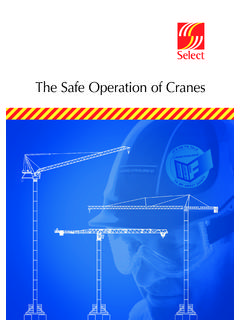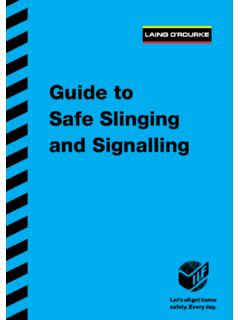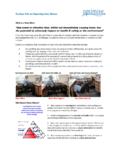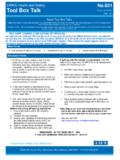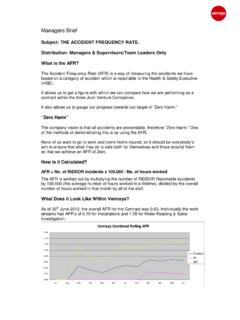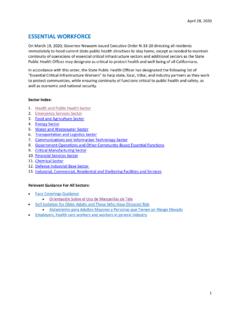Transcription of Cleaning Methodology and Processes (MAP) Issue Date: …
1 Document Ref: MFM(M)010/03 Cleaning Methodology and Processes (MAP) Manual Issue Date: 04/10/2010 Page No: 1 of 10 Index Introduction Page 2 Service provision Page 2 Infrastructure Page 2 Hours worked Page 2 Goods In/Out Page 2 Help desk Page 3 Sales process Page 3 QA process Colour coding of Cleaning Equipment Page 3 General Cleaning activities Page 4 Caretaking Page 4 Porter Duties/ Janitor/ Housekeeping Page 4 Specialist Cleaning Page 4 Body Fluids Page 5 Sales process Page 7 QA process Page 7 Window Cleaning Page 8 Task scheduling process Page 8 QA process Page 8 Useful Documentation Page 9 Document Ref.
2 MFM(M)010/03 Cleaning Methodology and Processes (MAP) Manual Issue Date: 04/10/2010 Page No: 2 of 10 Introduction This Manual relates to our Cleaning specific Processes and is authorised by the appropriate Managing Director. The use of this manual and its related procedures is mandatory, and should be followed in conjunction with the IMS manual MFM(M)001 and appropriate Group documentation. Any changes to this document can only be authorised as detailed in the procedure MG(P)270 - Document Control and Retention Procedure. Service provision The following unique services are covered in this manual; General Cleaning Caretaking Porter Duties Specialist Cleaning of high risk areas Window Cleaning . Infrastructure Personnel Single-site personnel Generally one employee permanently assigned to a specific site who will clean the client s premises during client dictated hours, predominately in the evenings.
3 These personnel may be classed as Lone Workers and as such the procedure MC(P)092 Lone Working may apply. Mobile personnel These employees are generally reactive and not tracked (excessive hours will be noted on the Top earners report ) Mobile personnel within some parts of the business respond to priority P1 or P2 calls received from the dedicated help desk. Most will carry out ad hoc work such as carpet Cleaning , body spillages, needle picking, deep cleans Retail teams clean bakery filters, etc. They also provide absence and holiday cover. Training provided for these personnel will be more advanced than that provided for single-site employees and may consist of specialist equipment and body spillage training. Vehicles are checked periodically by the relevant line manager or ad hoc by regional health & safety personnel to ensure serviceability using MG(F)741 Vehicle Checklist.
4 The contents of the vans are checked by the relevant line manager to ensure the equipment is secure and correct and where appropriate any required documentation is available and current. Hours worked process If required employees will sign into a customer s premises and record the hours worked on his/ her time-sheet. The time-sheets are sent to the local office where they are checked by the relevant Line manager for accuracy. Where the facility exists within businesses the time-sheets are checked against vehicle tracking systems. For those sectors of the businesses that use the Ezi-tracker electronic tracking system, the employee will book into the job by phoning in their unique pin number. Upon completion of the work the employee will book out by phoning the same number.
5 The duration of the time on site will be logged on a central database. Failure to log in or out results in a report being sent to the relevant line manager who will investigate to establish if it was a missed clean or the employee failed to log in or out. Goods in/ out process Cleaning & National Accounts: Document Ref: MFM(M)010/03 Cleaning Methodology and Processes (MAP) Manual Issue Date: 04/10/2010 Page No: 3 of 10 All Cleaning materials required for use by the employee are ordered through the relevant line manager or local office. If the delivery is over a certain limit they are delivered direct to the site by their nominated approved supplier, where the delivery is checked against the delivery note for accuracy. If delivered to the local office, once checked, they will be distributed by a mobile cleaner or the relevant line manager.
6 Retail Cleaning materials required for use in customer premises are dependant on the size of the client s store. These are categorised Tesco Extra Category 1, by the Operations team responsible for that client and a monthly standing order is generated to purchase the items required. Window Cleaning : All requirements are ordered through the Leeds office against a core list, which includes materials, specialist equipment and PPE. These invoices are signed off by the Regional Account Manager. Help desk process A help desk based at Bristol, which is part of a National call centre for businesses within MCES operates in accordance with MC(P)095 Call Centre Process to provide a reactive call out and complaints service. This is supplemented by a Northern help desk based in Leeds, which mirrors the Bristol process and supports operations based out of Knowsley, Salford, Tamworth and Leeds.
7 Sales process Sales teams use MC(M)004 - Sales Administration Manual and will follow the procedure MC(P)020 - Sales. Quality Assurance process Quality Assurance (QA) is mainly carried out by the Account Managers using the VisionIT system. However some businesses and regions will use a paper format such as client specific KPI s or the form MC(F)019 - Cleaning Inspection. Feedback to Cleaning teams will also be given following these inspections. Information from the report will be collated and reviewed at periodic operations meetings. Complaints received in the relevant offices are dealt with in accordance with MFM(P)003 Control of Non-conformities, Corrective and Preventive Action. In addition informal or formal customer review meetings will be carried out periodically to discuss the KPI s and any other issues.
8 Colour Coding of Cleaning equipment/ materials The main principle behind the use of colour coding equipment and materials is to reduce the risk of cross contamination within the areas that are cleaned. Cross-contamination Cross-contamination is a significant Issue for MITIE; thoroughly Cleaning one area and then dragging dirt and germs into another area of the building defeats the purpose of Cleaning . One of the best ways to help reduce cross-contamination is to use colour code Cleaning equipment so that certain tools and cloths etc are used only for certain tasks. Document Ref: MFM(M)010/03 Cleaning Methodology and Processes (MAP) Manual Issue Date: 04/10/2010 Page No: 4 of 10 Training It is essential that Client/Account managers and Facilities Managers ensure that personnel are trained in the correct use of the colour coded equipment and materials to try and reduce the risk of cross contamination.
9 General Cleaning activities These are carried out by either single-site or mobile personnel who will clean customer premises according to best practice as described by relevant trade associations such as; Cleaning Support Services Association (CSSA) and British Institute of Cleaning Science (BICS) with the use of generic or site specific method statements and/ or risk assessments. Caretaking Caretaking duties for commercial and local authority customers may require the employee to act as key holders on client s premises. In these situations they will be required to follow MC(Pol)007 - Clients Key Holders Policy. Duties may include the following: Basic maintenance; Use of hand tools, painting, etc. All tasks must have a risk assessment and/ or method statement in place and be authorised by the Regional Healthy & Safety team.
10 Pressure washing Cleaning tasks Porter/ Janitor/ Housekeeping These activities are provided for both commercial and local authorities and can be split into the following categories of tasks; Porter Duties Document Ref: MFM(M)010/03 Cleaning Methodology and Processes (MAP) Manual Issue Date: 04/10/2010 Page No: 5 of 10 Moving furniture Setting up/ clearing meeting rooms General light tasks Service checks on toilets Although these tasks are generally light duties some may require lifting and carrying large or heavy objects. Where this is the case, in addition to generic or site specific risk assessments, personnel will be required to follow MG(P)215 Manual Handling. Specialist Cleaning These jobs are carried out according to site specific method statements and risk assessments.

